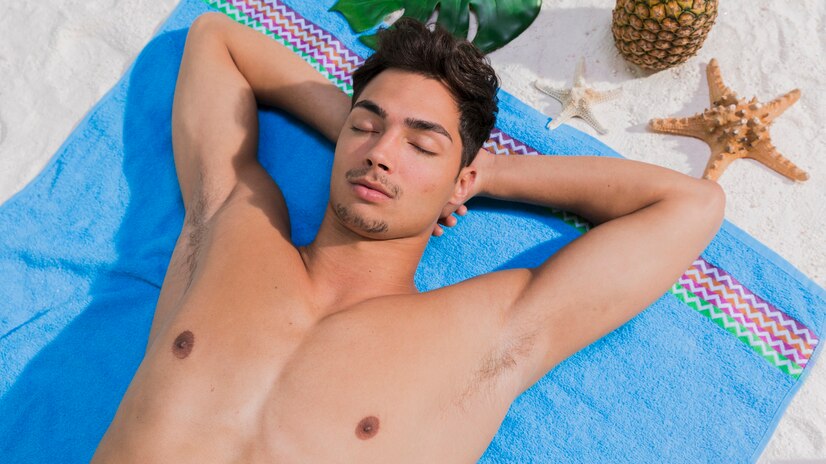
Sunburn scalp is a common yet often overlooked consequence of sun exposure. While we diligently slather sunscreen on our faces, arms, and legs, we tend to forget that our scalp is equally susceptible to the sun's harmful rays. The delicate skin on the scalp can easily get sunburned, leading to discomfort, pain, and potential long-term consequences.
In this blog post, we will explore the causes, symptoms, prevention, treatment, and aftercare for sunburn scalp, emphasizing the importance of protecting this often neglected area. So, let's dive in and learn how to keep our scalps sunburn-free and healthy.
What is a Sunburn Scalp?
Scalp sunburn happens when the skin on the scalp gets burned due to overexposure to the sun's ultraviolet (UV) radiation. While many people associate sunburn with the more commonly exposed areas of the body, such as the face, arms, and legs, the scalp is equally susceptible to sunburn.

Scalp sunburn can occur in various areas, including:
Along the hairline:
The skin along the edges of the hairline, especially around the forehead and temples, is often exposed to the sun. Without proper protection, this area can easily get sunburned.Along hair parts:
If you have a distinct part in your hair, the exposed skin along the parting line is at risk of sunburn. This is particularly true if you spend a significant amount of time outdoors without any sun protection for your scalp.In areas of hair thinning or baldness
: Individuals experiencing hair thinning or baldness are more prone to scalp sunburn. The absence of hair leaves the scalp vulnerable to direct sunlight, making it more susceptible to sunburn.All over the scalp
: Even if you have a full head of hair, the entire scalp can still be affected by sunburn if left unprotected. Prolonged sun exposure without any shielding measures can result in sunburn on the entire scalp surface.Causes of Sunburn Scalp
When it comes to sunburned scalp, several factors can contribute to its occurrence. Understanding these causes can help us take proactive measures to protect our scalps from the sun's harmful effects. Here are some common causes:
Lack of hair coverage
: Our hair acts as a natural shield against the sun's UV rays. However, individuals with thinning hair or those who shave their heads have less natural protection, making their scalps more vulnerable to sunburn.Neglecting to apply sunscreen or protective measures to the scalp
: While we may be diligent about applying sunscreen to exposed areas of our bodies, the scalp often goes unnoticed. Forgetting to apply sunscreen or using insufficient amounts can leave the scalp unprotected and susceptible to sunburn.Prolonged sun exposure without proper headwear
: Spending extended periods in direct sunlight without wearing a hat, cap, or other protective headwear significantly increases the risk of sunburn scalp. Whether it's lounging by the pool, engaging in outdoor activities, or simply enjoying a sunny day, failing to shield the scalp can lead to painful sunburn.Symptoms and Effects of Sunburn Scalp

Sunburn scalp can cause a range of symptoms and have various effects on the affected area. Recognizing these signs is important in order to take appropriate action and provide relief. Here are the common symptoms and effects of sunburn scalp:
Redness and tenderness of the scalp
Sunburned skin often becomes visibly red and may feel warm or tender to the touch. The intensity of redness can vary depending on the severity of the sunburn.
Itchiness and irritation
Sunburned scalp may become itchy and irritated, leading to discomfort and a persistent urge to scratch. However, scratching can further damage the skin and delay the healing process.
Peeling or flaking of the skin
As the sunburn begins to heal, the affected skin on the scalp may start to peel or flake off. This is a natural part of the skin's renewal process and is more likely to occur with more severe sunburns.
Pain and discomfort
Sunburned scalp can be painful, especially when touched or exposed to heat. The discomfort can range from mild to severe, depending on the extent of the sunburn.
Headache and sensitivity
In some cases, a sunburned scalp can lead to headaches and increased sensitivity to light. This can be a result of the inflammation and irritation caused by the sunburn.
Increased risk of skin cancer
Prolonged or repeated sunburns on the scalp can have long-term consequences, including an increased risk of developing skin cancer. The scalp is often an overlooked area when it comes to sun protection, making it important to take preventive measures to reduce this risk.
Prevention of Sunburn Scalp
Preventing sunburn on the scalp requires proactive measures to shield this often neglected area from the sun's harmful UV rays. By following these preventive tips, you can significantly reduce the risk of sunburn on the scalp:

Wearing a hat or cap for sun protection
: Invest in a wide-brimmed hat or a cap with a neck flap to provide ample shade and protect your scalp from direct sunlight. Opt for hats made from tightly woven fabrics that offer UPF (Ultraviolet Protection Factor) for enhanced sun protection against sunburn on scalp.Using sunscreen specifically designed for the scalp
: Apply a broad-spectrum sunscreen with a minimum SPF (Sun Protection Factor) of 30 to the exposed areas of your scalp, including the hairline, part line, and any areas of hair thinning or baldness prone to sunburn on scalp. Look for sunscreens that are water-resistant and specifically formulated for the scalp to ensure effective protection.Seeking shade or avoiding peak sun hours
: Whenever possible, seek shade under trees, umbrellas, or canopies to minimize direct sun exposure on your scalp prone to sunburn. Additionally, try to plan outdoor activities during the early morning or late afternoon when the sun's rays are less intense.Applying natural remedies for added protection
: Some natural ingredients can provide an additional layer of sun protection and nourishment for your scalp prone to sunburn, including sunburn on scalp peeling. Consider using natural oils like jojoba oil to moisturize your scalp and provide some level of sun protection. However, keep in mind that natural remedies should not replace the primary protection offered by hats and sunscreen.Ensuring complete coverage:
Pay attention to areas along the hairline, parts, and any areas of hair thinning or baldness prone to sunburn on the scalp peeling. Apply sunscreen or wear headwear that adequately covers these areas to ensure complete protection against sunburn on scalp.Treatment and Relief for Sunburn Scalp

If you find yourself dealing with a sunburned scalp, there are several treatment and relief options to alleviate discomfort and promote healing, especially when scalp peeling from sunburn becomes a concern. Here are some approaches you can take:
Gently cleansing the scalp
When washing your hair, use a gentle, sulfate-free shampoo to cleanse the scalp without causing further irritation to the peeling areas. Avoid using harsh hair products that can potentially worsen scalp peeling from sunburn. After washing, pat dry the scalp with a soft towel instead of rubbing vigorously.
Avoiding further sun exposure
Protect your sunburned scalp, especially areas experiencing scalp peeling, from further sun exposure until it has healed completely. Sun exposure on already sunburned and peeling skin can exacerbate the condition and delay the healing process.
Applying cool compresses
Gently place a cool, damp cloth or towel on the sunburned scalp. This can help soothe the area, reduce inflammation, and provide temporary relief from pain and discomfort caused by scalp peeling from sunburn.
Using aloe vera gel or moisturizers
Apply aloe vera gel or a fragrance-free moisturizer to the sunburned scalp. Aloe vera has soothing properties that can help alleviate inflammation and provide relief. Additionally, keeping the scalp moisturized can minimize the dryness and tightness associated with scalp peeling.
Taking over-the-counter pain relievers
If you experience pain or discomfort, consider taking over-the-counter pain relievers like ibuprofen or acetaminophen. These medications can help reduce pain, inflammation, and headache caused by sunburn on the scalp, including scalp peeling.
Addressing scalp peeling
If your sunburned scalp starts to peel, it's important to resist the urge to pick or forcefully remove the peeling skin. Doing so can prolong the healing process and potentially lead to further damage or infection. Instead, keep the scalp moisturized with aloe vera gel or a moisturizer to promote the natural shedding of dead skin cells and alleviate scalp peeling.
When to Seek Medical Attention
In most cases, sunburn on the scalp can be effectively treated at home with self-care measures. However, there are situations where seeking medical attention for sunburn scalp is necessary. If you experience any of the following, it is important to consult a healthcare professional:
Severe pain or discomfort
: If your sunburn on the scalp is accompanied by severe pain that does not improve with over-the-counter pain relievers or causes significant distress, medical attention is recommended. Severe pain could be an indication of a more serious burn or complications.Blistering or open sores
: If your sunburned scalp develops blisters or open sores, it may be a sign of a second-degree burn. In such cases, medical evaluation is necessary to assess the extent of the burn and prevent infection.Signs of infection
: If you notice signs of infection on your sunburned scalp, such as increasing redness, swelling, warmth, pus, or fever, it is important to seek medical attention. Infections can complicate the healing process and may require medical intervention, such as antibiotics.Systemic symptoms
: If you experience systemic symptoms like dizziness, nausea, vomiting, or a high fever following sunburn on the scalp, it could be an indication of a more severe reaction. Seek immediate medical attention in such cases.Conclusion
Protecting your scalp from sunburn is just as important as safeguarding other sun-exposed areas of your body. By adopting preventive measures, recognizing the symptoms and effects of sunburn scalp, and knowing how to provide appropriate treatment and relief, we can minimize the risks and discomfort associated with this condition. Remember, our scalp deserves the same attention and care we give to the rest of our skin.







